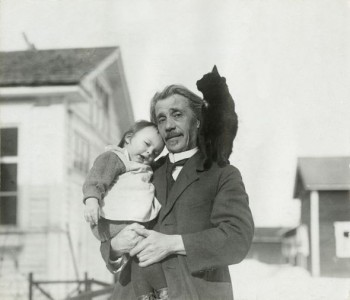In defence of small people
15 November 2012 | Non-fiction, Reviews

Teuvo Pakkala with grandson Teuvo-Pentti and Mirri the cat. Photo: F. Suomela / Otava, 1922
The best-known work of author Teuvo Pakkala (1862–1925) is Tukkijoella (‘On the log river’, 1899), Finland’s most-performed play. The song-studded comedy set in motion a phase of ‘logger romanticism’ in Finnish literature which later spread to film as well. Like the cowboy of the old west, the wandering lumberjack became the prototype for the Finnish masculine adventurer.
The entertaining musical play was a blockbuster. Pakkala’s works of more literary significance, however, encountered more difficulty. His short story collections on the lives of children – Lapsia (‘Children’, 1895) and Pikku ihmisiä (‘Little people’, 1913) – were greeted with flattering acclaim, but marked the author as hopelessly ‘effeminate’, as the critics put it. The stories were read as a kind of child-rearing guide, or even as tales for children. It wasn’t until much later, in the second half of the 20th century, that these psychological studies of children were re-examined as early gems of the short story form by a contemporary of Freud.
Pakkala’s status in the pantheon of national literature was a secondary one from the beginning. The foundation of Finnish prose and drama wasn’t laid until the 1880s and 90s, following the death of Aleksis Kivi (in 1872): it was made up of Minna Canth (1844–1897), Juhani Aho (1861–1921), and Teuvo Pakkala. History has always ordered them thus, by age, but the ranking also reveals the distinct characteristics of each author’s public image. While Canth (a radical force in her day in terms of both gender and subject matter) and Aho (a journalist, essayist and storyteller) were extremely well-known and publicly visible, Pakkala – born Teodor Frosterus – was an aloof, withdrawn personality. The greater part of his living he made as a translator and a teacher of French and Finnish.
In his twin novels Vaaralla (‘On the hill’, 1891) and Elsa (1894), he told the stories of two women who were a variation on the tragic, fallen angels typical of the realist-naturalist literature of the day. His first short story collection ‘Lapsia’ featured a store of characters from his novels raised to central roles. The focus, dramatisation and stylisation in these works marked the birth of the Finnish objective short story.
In ‘Poikatyttö’ (‘The tomboy’), from the collection Lapsia, Liisa is physically strong, good at running, riding, and, when necessary, fighting. Defined gender roles are exuberantly transgressed when this ‘toughest mug’ in town protects a gang of girls from the mischief of the boys. In the novel Elsa the same Liisa is an adult, a liberated Scandinavian woman – or, in the jargon of the day, an ‘amazon’ – a prototype whom we meet as the sailor’s wife with a strong sense of justice who slams her fist down on the table in a fit of moral righteousness at an auction of poor people. Liisa assiduously looks out for the weak and takes care of others’ children and elders as well as her own. This stands out as a dynamic opposite of the factory girl lured into a rich man’s trap that was typical of naturalistic novels. It’s interesting how contemporary queer theorists considering concepts of gender end up returning to Pakkala’s 19th century characters to find the birth of boundary-breaking women.
The author who depicted children, women, old people, and the disabled in his works played a visible role as an advocate for the lower classes, but in his short stories he emphasised not suffering victims but the child’s own active point of view, imagination, and boundless energy. In giving his second story collection the title ‘Little people’ he reminded us why he portrayed children. In a child, levels of human awareness can be seen laid bare, in a kind of rich, natural state.
Pakkala called for societal change in the raising of children and young people. In his teaching, too, he applied encouragement and appreciation of the personality. A hard-line Fennoman educationalist at the lyceum in Kokkola, where he taught from 1907 to 1920, Pekkala boldly demanded replacing Swedish language study with French. Pakkala allowed the children to move about freely in the classroom and opposed such things as rote memorisation.
Teuvo Pakkala left at least two words to the Finnish language – poikatyttö (tomboy), and stiiknafuulia. Pakkala originally plucked the latter word from the mixed Swedish and Finnish used by the children of Oulu, and it plays the title role in the short story ‘Mahtisana’ (‘The mighty word’). It is a kind of gibberish that is accepted as a means of wielding power without anyone necessarily understanding what it means. One of the children in the story claims he is a stiknafoolia, and the others, stunned by this strange and mighty word, don’t know how to dispossess him of his power. The nonsense verbiage and pretentious form of stiiknafuulia still serve as a tart warning to contemporary coiners of pompous terms lacking true content.
Translated by Lola Rogers
Tags: literary history, short story
No comments for this entry yet
